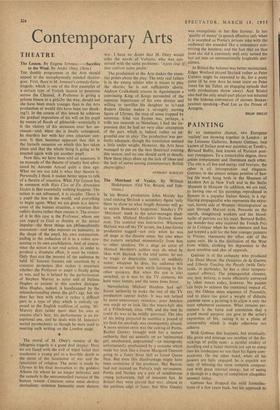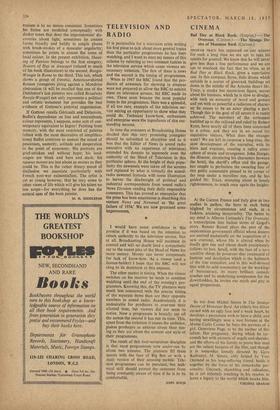PAINTING
BY an instructive chance, two European 'realists' are showing together in London : at the Leicester Galleries, Renato Guttuso, best known of Italian post-war painters; at Tooth's, Bernard Buffet, best known of Parisian post- war youngsters. To a remarkable degree, these artists complement and illuminate each other. The one is all fire and energy and bravura: the other is all introspection and elegance. Guttuso, in the almost unique position of hav- ing his work hung both in the Museum' of Modern Art in New York and in the Stalin Museum in Moscow (in addition, we are told, to having one of his paintings reproduced in flowers in a popular Italian fiesta), is a rip- toaring propagandist who represents the extro- vert, heroic side of Western 'disintegration' as seen through Marxist eyes. Peasants on the march, slaughtered workers and the blood- baths of patriots are his meat. Bernard Buffet, the wonder-boy who received the French Prix de la Critique when he was nineteen and has just topped a p6I1 for the best younger painters in France, represents the other side of the same coin. He is the disillusion of the West from within, clothing his depression in the most sensitive and chic of apparels.
Guttuso is of the company who produced The Dead Marat, the D'esastres de In Guerra, and Liberty Guiding the People (with Dela- croix, in particular, he has a clear tempera- mental affinity). The propagandist element. one may believe, is more efficiently conveyed by other means today, however. No painter can hope to achieve the emotional impact of, say, the Odessa steps sequence of Potemkin. and to place too great a weight of didactic purpose upon a painting is to allow it only the most ephemeral existence. What remains per- manent is the force and conviction that a grand moral purpose can give to the artist's expression of life, raising it to a plane of universality which it might otherwise not achieve.
With Guttuso this happens, but erratically. His gusto and courage are careless of the fin- nickings of polite taste : a painful crudity of handling and a banal rhetoric are apt to creep into his landscapes no less than his figure com- positions. On the other hand, when all his powers are fully engaged, he is capable not only of infusing the most complex composi- tion with great internal energy, but of seeing it through to a degree of completion altogether unusual today.
Guttuso has dropped the mild formalisa- tions of a few years back, but his approach to realism is by no means consistent. Sometimes his forms are modelled conceptually with darker tones that deny the impressionists' dis- coveries about light; sometimes he creates forms broadly and boldly in simple planes with brush-strokes of a muscular angularity; sometimes he paints in almost flat tones of local colour. In the present exhibition, Shoot- ing of Patriots belongs to the first category, Bearers of Hay at Anacapri (related to much of his book illustration) to the second, Boogie- Woogie in Rome to the third. This last, which shows a group of frenetic, Amcrican-shirted Roman youngsters jiving against a Mondrian abstraction (it will be recalled that one of the Dutchman's last pictures was called Broadway Boogie-Woogie) not only represents a political and artistic testament but provides the best evidence of Guttoso's pictorial organisation.
If Guttoso recalls Gericault and Delacroix, Buffet's dependence on line and neurasthenic colour represents, I suppose, some sort of con- temporary equivalent to Ingres! Painting from memory, with the most restricted of palettes (albeit with the most decorative of simplifica- tions) Buffet contrives to sustain the mood of pessimism, austerity, solitude and desperation to the point of monotony. His portraits arc grief-stricken and without hope; his land- scapes arc bleak and bare and stark; his natures martes arc just about as mortes as they could be. This is the rather dreary mood of disillusion we associate particularly with French post-war existentialism. The artist is yet so young however, that he may come to other views of life which will give his talent no less scope—for everything he does has the natural case of the born painter.
M. Ii. MIDDLETON











































 Previous page
Previous page